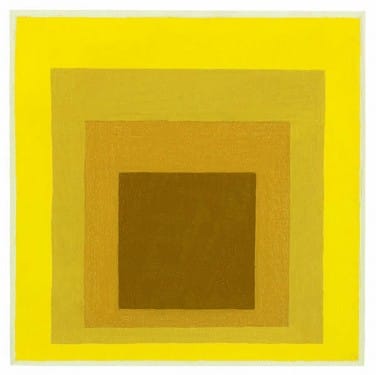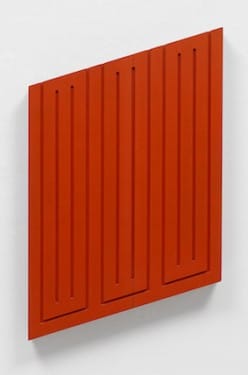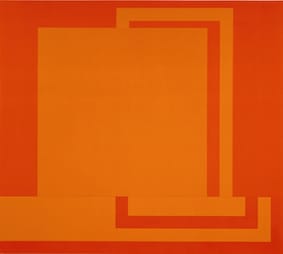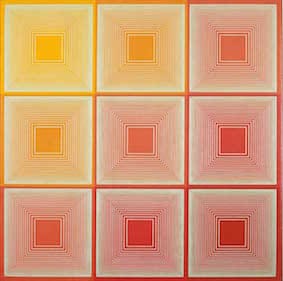
Josef Albers Estudio para Homenaje al Cuadrado Hard, Softer, Soft Edge
In the Arts District of Buenos Aires is the Museum of Contemporary Art known as MACBA. This museum was founded by collector and economist Aldo Rubino, who started a collection in the 1980s based on local and international contemporary art with particular emphasis on geometric abstraction. The mission of the collection is to acquire, preserve, research, document, communicate and exhibit national and international contemporary art.
The building stands tall on San Juan Avenue in one of the oldest and most traditional neighborhoods in Buenos Aires. The neighborhood of San Telmo has cobbled streets, low houses and courtyards with wells. The result is an interesting contrast of architectural styles. Like the collection inside, the building is a minimalistic geometric and contemporary structure with four floors and, until March 13, 2016, four sections that reflect an investigation into geometric art.
Geometric art is framed by the Abstract art developed in the 1920s, and is based on the use of simple geometric shapes combined in compositions that show the accurate and harmonic distancing of subjectivity. It arose as a reaction to the excessive lyricism of action painting and other currents of the time.
 Through thirty works from the museum's collection, the MACBA celebrates fifty years since an iconic display at the Museum of Modern Art (MOMA) in New York. The Responsive Eye, curated by William Seitz, showed the overall picture of Op Art with works by contemporary artists from around the world. It focused on aspects of the perception of art--a the illusion of movement and interaction of color relationships.
Through thirty works from the museum's collection, the MACBA celebrates fifty years since an iconic display at the Museum of Modern Art (MOMA) in New York. The Responsive Eye, curated by William Seitz, showed the overall picture of Op Art with works by contemporary artists from around the world. It focused on aspects of the perception of art--a the illusion of movement and interaction of color relationships.
The exhibition Geometric Obsession. American School 1965-2015 presents pieces from artists of the American School who exhibited at the iconic exhibition as well as Contemporary artists who give continuity to the school. This results in a dialogue between the beginning and the development of geometric art today.
 This collection was conceived under the initiative and vision of its CEO Aldo Rubino and curated by the North American critic Robert Morgan, who is one of the most prestigious curators of the United States and has had an extensive academic career. Morgan creates a clear narrative, which presents works of researchers who expanded the field of geometric art and begins with a work that tells us about the beginning of the movement. In the op art room with "Study for Homage to the Square: Hard, Softer, Soft Edge" by Josef Albers, we see the legacy that followed artists that left Nazi Germany after the Bauhaus art school closed before World War II.
This collection was conceived under the initiative and vision of its CEO Aldo Rubino and curated by the North American critic Robert Morgan, who is one of the most prestigious curators of the United States and has had an extensive academic career. Morgan creates a clear narrative, which presents works of researchers who expanded the field of geometric art and begins with a work that tells us about the beginning of the movement. In the op art room with "Study for Homage to the Square: Hard, Softer, Soft Edge" by Josef Albers, we see the legacy that followed artists that left Nazi Germany after the Bauhaus art school closed before World War II.
 Josef Albers was an artist and educator who developed the theory of colors and their interdependence. He captured the phenomenon in almost a scientific way in his works. In the "Study for Homage to the Square: hard, Softer, Soft Edge ", we see four squares located concentrically in a range of yellows that brings us inside the piece. In the same room are Francis Hewitt’s "op-end # 2", Ernst Benkert’s "overlap No.3 (crimson And Blue)", Mieczkowski’s " Small Bloc # 2", as well as works by Julian Stanczak, Beckmann, Richard Anuszkiewicz and Rakuko Naito. Naito created a series of games that trick the eyes and the viewer’s perception. The study of color and classical geometry leads to destabilizing effects. This is managed through illusions, overlapping, repetitions and variations like discordant figure-ground relationships that puts the foreground and background in a tense and contradictory juxtaposition.
Josef Albers was an artist and educator who developed the theory of colors and their interdependence. He captured the phenomenon in almost a scientific way in his works. In the "Study for Homage to the Square: hard, Softer, Soft Edge ", we see four squares located concentrically in a range of yellows that brings us inside the piece. In the same room are Francis Hewitt’s "op-end # 2", Ernst Benkert’s "overlap No.3 (crimson And Blue)", Mieczkowski’s " Small Bloc # 2", as well as works by Julian Stanczak, Beckmann, Richard Anuszkiewicz and Rakuko Naito. Naito created a series of games that trick the eyes and the viewer’s perception. The study of color and classical geometry leads to destabilizing effects. This is managed through illusions, overlapping, repetitions and variations like discordant figure-ground relationships that puts the foreground and background in a tense and contradictory juxtaposition.
The path of the museum visitor continues to move through the school of Color, Minimal Art, Light and Space, and Hard Edge. In the Hard Edge section, abrupt transitions are found between color areas. In the area dedicated to Color Field are pieces characterized primarily by large fields of flat, solid color spread across or stained into the canvas, creating areas of unbroken surface and a flat picture plane. The section on Shaped Canvas paintings shows works that depart from the normal flat, rectangular configuration. Then there are the works of the Moire Movement. In those, two or more identical patterns are overlaid while either displaced or rotated in a small area around one another.
In the Light and Space room, the space is dark, with illuminated works creating patches of light and color. The curator manages to create a space that works with the sensuality of the art. With artists like James Turrell, Larry Bell and Mary Corse, we explore the response of the pieces to their environments and the internal complexities that are revealed when viewers change their position. With John McLaughlin and Donald Judd’s minimalistic works, we see the elimination of gestural marks and the search for full expression through the minimum use of elements. The spacial substance of the art is no longer exemplified by light but rather through the density of the material.
The narrative continues with pieces like "Blue-violet" by Gene Davis, "# 14 " by Karl Stanley, " Figure Of Speech" by Frederick Hammersley and "Center Split" by Howard Mehring.
Neil Williams’ work shows the shaped canvas and works to break definitively with the idea rectangular support—the last vestige of the classical conception of art as a window opening to the world.
 Larry Zox and Neil Williams bring us a reinterpretation of classical geometry where the predominant octagon is used to introduce the diagonal forms. In Minimalism, we already observed the intent to eliminate the expression of the brushstroke. These artists improved the idea through different techniques such as using tape and the implementation of other materials. This can be seen in “Isolation Confirmed (Php 89-07)” by Peter Halley, the work that precedes the final chapter of the exhibition.
Larry Zox and Neil Williams bring us a reinterpretation of classical geometry where the predominant octagon is used to introduce the diagonal forms. In Minimalism, we already observed the intent to eliminate the expression of the brushstroke. These artists improved the idea through different techniques such as using tape and the implementation of other materials. This can be seen in “Isolation Confirmed (Php 89-07)” by Peter Halley, the work that precedes the final chapter of the exhibition.
In the last level of MACBA is the room where new trends are exhibited. In this room live Mark Dagley’s "Concentric Sequence" and Jim Isermann’s "Untitled (Pantone Yellow 124, Blue 285, Green 3965)”, among other works from Quaytman, Michael Scott and Dan Walsh.
This group of artists takes the theories of geometric art to a more conceptual place. Stencils, patterns, and new materials enrich these pieces. In "Concentric Sequence", Mark Dagley used primary-colored dots drawn using compass and pencil to build a long spiral. The effect is almost hypnotic. Departing from op art traditions, the variations are irregular and vertigo inducing, causing the viewer to feel as if they could fall into it.
 Dan Walsh’s "Days and Nights-Nights" presents large-scale paintings that draw on the tradition of minimalism without sacrificing the geometric art aspects. Through repetition, modules, changes of scale and complex techniques using stencils and negative and positive space, his creation has a multiplicity of forms that suggest an endless expansion. The cracks and unexpected accumulations of paint increase the expressiveness of the piece.
Dan Walsh’s "Days and Nights-Nights" presents large-scale paintings that draw on the tradition of minimalism without sacrificing the geometric art aspects. Through repetition, modules, changes of scale and complex techniques using stencils and negative and positive space, his creation has a multiplicity of forms that suggest an endless expansion. The cracks and unexpected accumulations of paint increase the expressiveness of the piece.
All the works across the display have an obsessive precision that is guided by mathematical and scientific theories. The new trends, without neglecting precision, add a slight looseness to the previous styles. Curator Robert Morgan referred to this reinterpretation of geometric art as "precisely imprecise".
Geometric Obsession. American School 1965-2015 curated by Robert C. Morgan will be open to the public in MACBA until March 13th, 2016. The museum will organize a series of activities around the exhibition. The exhibition will then travel to different parts of the country and Latin America, first stopping in Chile. The exhibit and those responsible for it plan to work with public institutions and nongovernmental organizations that identify with its values of furthering education.
